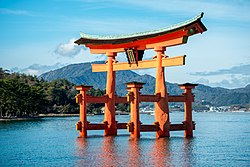Shinto
Shinto (Japanese: 神道) is a form of Japanese animism. It has many kami, translated as gods or nature spirits. Some "kami" are just spirits of certain places, and some are the overall "kami" (like "Amaterasu", the Sun goddess). The word "Shinto" comes from the Japanese words "神", shin—the word for spirit or god, and "道", tō—the word for "the way" or "path". So, Shinto means "the way of the gods."
State Shinto was the main religion of Japan before World War II. During the period 1868 to 1945 the Japanese government used Shinto for propaganda. All Japanese were forced to register with their local shrine. All Shinto priests worked for the government. War was seen as a sacred duty. The Emperor of Japan was seen as a god. Japanese Buddhism was also involved with the war effort (See Zen at War).
Shinto has many rituals and customs, and some are done every day. Festivals are frequent. Some people mix Shinto and Buddhist rituals and beliefs.
- Although Jinja-Honcho manages almost all shrines, some, such as Yasukuni, are run separately.
- Amaterasu, the Sun Goddess, is seen as the holiest of all Shinto kami. Her shrine is in Ise, Japan.
Shinto Media
An artistic depiction by Utagawa Kuniyoshi of the kami Inari appearing to a man
A 3000 year old sacred tree (shintai) of Takeo Shrine
Shinto purification rite after a ceremonial children's sumo tournament at the Kamigamo Jinja in Kyoto
The main gate to Fushimi Inari-taisha in Kyoto, one of the oldest shrines in Japan
Yutateshinji ceremony performed by Shinto priests at the Miwa Shrine in Sakurai, Nara
Related pages
Other websites
- Kokugakuin University Encylopedia of Shinto Archived 2009-04-03 at the Wayback Machine
| Wikimedia Commons has media related to Lua error in Module:Commons_link at line 62: attempt to index field 'wikibase' (a nil value).. |











